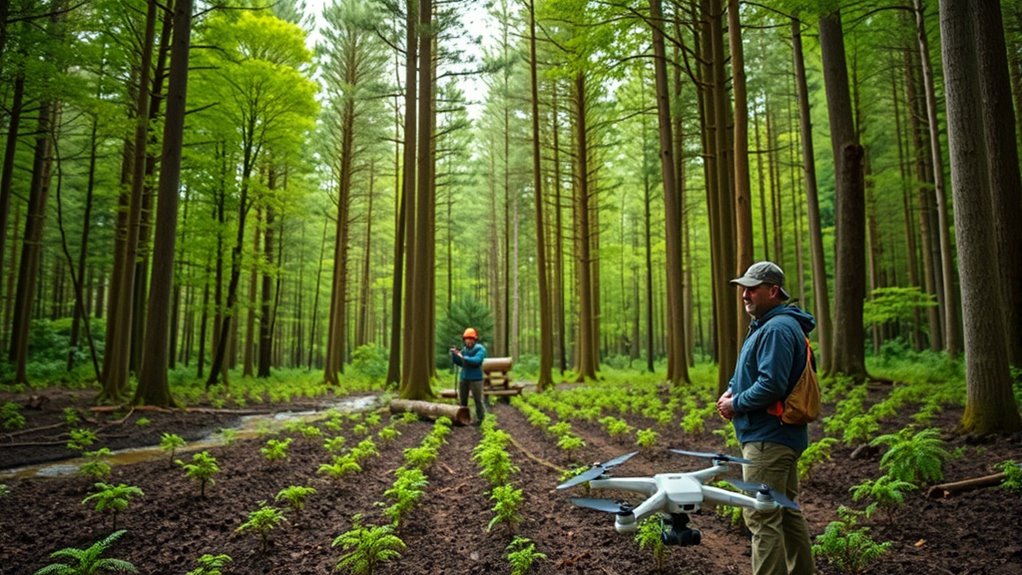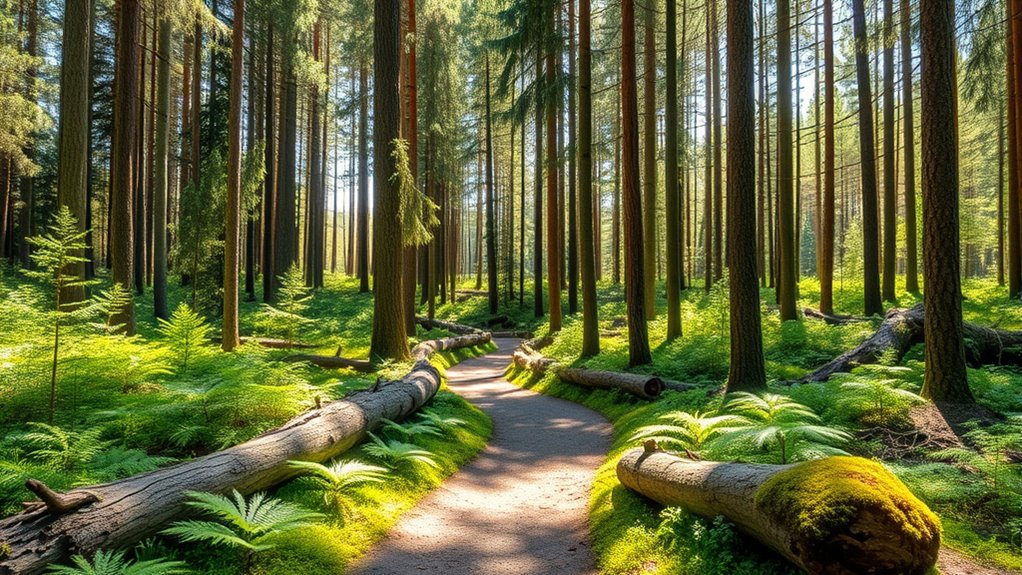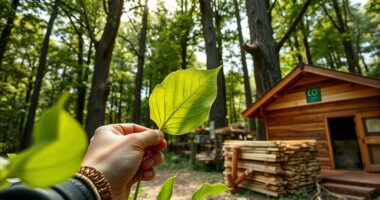In New Zealand, sustainable forestry involves careful long-term management using strict regulations and approved plans that prioritize ecological health and growth. They actively protect forests from pests, diseases, and weeds through biosecurity measures, early detection, and integrated control methods. Innovations and research support healthier forests, while policies and industry initiatives promote responsible practices like certification schemes. If you explore further, you’ll discover how these exhaustive strategies work together to ensure forests thrive well into the future.
Key Takeaways
- Native forest management is guided by long-term sustainability plans approved under legislation like the Forests Act 1949.
- Biosecurity measures and early detection strategies prevent and control pests, diseases, and invasive weeds.
- Integrated pest management combines biological controls with chemical methods to minimize environmental impact.
- Industry initiatives and government-funded programs support reforestation, resilient planting, and sustainable land use practices.
- Certification schemes like FSC promote responsible forestry, ensuring sustainable harvesting and ecological health.
Managing Native Forests for Long-Term Sustainability

Managing native forests for long-term sustainability in New Zealand requires careful planning and strict regulation. You need to follow legal frameworks like the Forests Act 1949, which set clear rules for balancing timber production with conservation. Sustainable forest practices involve creating detailed, MPI-approved management plans that prevent overharvesting and ensure native forests remain healthy. These plans include regular mapping, monitoring, and adaptive strategies to address threats like pests, diseases, and environmental changes. When native timber is harvested on private land, it’s considered sustainable if practices align with these approved plans and respect natural growth rates. By adhering to these regulations, you help maintain the ecological integrity of native forests while supporting ongoing economic benefits, ensuring a sustainable forest future for New Zealand. Implementing high-quality monitoring methods is essential to accurately assess forest health and ensure compliance with sustainability standards. Additionally, integrating technical advancements can improve the precision and effectiveness of forest management efforts. Employing vegetable juices and other natural products can also support ecosystem health by promoting biodiversity and soil vitality. Furthermore, establishing community engagement programs encourages local stewardship and enhances the long-term sustainability of native forests.
Protecting Forests From Pests, Diseases, and Weeds

To protect forests from pests, diseases, and weeds, you need effective prevention and control strategies. Working with Biosecurity New Zealand helps identify threats early and implement targeted actions. By staying vigilant and proactive, you can help safeguard New Zealand’s native and commercial forests from ecological damage.
Pest and Disease Prevention
New Zealand actively works to prevent pests, diseases, and weeds from threatening its forests by collaborating with Biosecurity New Zealand to identify and control invasive species. This partnership focuses on early detection and rapid response to protect native forests and industries. Effective measures have eradicated pests like the painted apple moth and white spotted tussock moth, demonstrating the country’s commitment. However, pests like pine needle diseases (Dothistroma needle blight and red needle cast) still pose economic challenges. Kauri trees face threats from Phytophthora Agathidicida, prompting ongoing biosecurity efforts. These strategies emphasize prevention measures, ensuring pests and diseases don’t spread further. The growing financial investments in biosecurity highlight the importance of global entertainment industry and its influence on national economies.
Weed Control Strategies
Effective weed control in New Zealand forests relies on a combination of strategies to prevent invasive plants from taking hold and spreading. You play a crucial role in forest management by using methods like physical removal, chemical herbicides, biological control agents, and habitat modification. These approaches help prevent weeds such as wilding conifers, which threaten erosion-prone areas and native ecosystems. Monitoring and early detection are essential, allowing you to respond quickly to new infestations before they spread widely. Support from government programs and partnerships with landowners strengthens these efforts, ensuring biodiversity, water quality, and forest productivity are protected. By actively implementing integrated weed control strategies, you help sustain New Zealand’s forests and their unique ecosystems for future generations.
The Role of Biosecurity in Forest Conservation

Biosecurity plays a crucial role in forest conservation by actively preventing the introduction and spread of invasive pests and diseases that threaten New Zealand’s native and plantation forests. You rely on biosecurity measures, working closely with Biosecurity New Zealand, to identify and eliminate risks before they reach your forests. Priority threats like the painted apple moth and Phytophthora agathidicida (kauri dieback) are carefully monitored through strict quarantine protocols, import controls, and surveillance. Managing invasive weeds and pests, such as wilding conifers, is essential for maintaining forest health and biodiversity. Your efforts protect not only native ecosystems but also the sustainability of primary industries. Without effective biosecurity, invasive pests could cause irreversible damage, undermining conservation goals and long-term forest resilience.
Approaches to Pest and Disease Control in New Zealand

You play a key role in pest and disease control by supporting identification and monitoring efforts that track threats early on. Combining biological and chemical controls helps manage pests effectively while minimizing environmental impact. Success depends on strong cooperation between communities, landowners, and industry to implement coordinated strategies. Utilizing low light office plants can also contribute to healthier indoor environments, indirectly supporting overall ecosystem resilience. Moreover, incorporating AI-driven diagnostics can enhance detection and response times for emerging threats, improving overall management practices. Implementing integrated pest management strategies ensures sustainable and effective control measures are maintained over time, reducing reliance on chemical interventions. Utilizing vetted home theatre projectors can also improve educational outreach and awareness campaigns related to pest management efforts. Additionally, embracing holistic care models can help address social and environmental factors that influence pest and disease dynamics, promoting long-term sustainability.
Pest Identification and Monitoring
To protect New Zealand’s native forests and industries from invasive pests, the country employs a thorough system for pest identification and monitoring. You’ll find that pest detection begins with a detailed identification process, focusing on threats like the painted apple moth and white spotted tussock moth. Monitoring methods include regular inspections, trapping, and sentinel trees that signal early pest activity. Advanced tools, such as pheromone traps and molecular diagnostics, enhance detection accuracy and help track pest population changes. Rapid biosecurity responses are vital, with eradication efforts successfully removing pests like the painted apple moth. Collaboration with regional authorities, industry groups, and research institutions ensures continuous pest monitoring, enabling swift action to safeguard New Zealand’s unique ecosystems and forestry industries. Additionally, implementing AI-powered detection techniques can further improve early identification and response times, making pest management even more effective. Developing targeted control strategies based on monitoring data helps reduce the impact of invasive pests and protect native biodiversity. Incorporating integrated pest management approaches can also optimize control efforts while minimizing environmental impact. Employing remote sensing technology can provide comprehensive surveillance over large forest areas, increasing early detection capabilities.
Biological and Chemical Controls
In New Zealand, effective pest and disease management combines biological and chemical controls to protect native forests and industries. You’ll find biological controls involve introducing or boosting natural predators, parasites, or pathogens to keep pests in check. These methods are carefully monitored by the New Zealand Forest Service and MPI to ensure safety and effectiveness. Chemical controls are used selectively, often alongside biological methods, to target outbreaks of pests like the painted apple moth or kauri dieback disease. Here’s how they work together: 1. Biological controls use specific agents like nematodes or fungi to target pests with minimal ecosystem impact. 2. Chemical controls provide fast, targeted suppression during outbreaks. 3. Both methods are integrated into pest management strategies to balance environmental health with forest protection. Additionally, implementing maximized space and organization in forest management practices can enhance monitoring and response efficiency.
Community and Industry Cooperation
Effective pest and disease control in New Zealand relies on strong collaboration among government agencies, industry groups, and landowners. The community plays a crucial role in implementing regional pest management strategies tailored to local issues. Industry organizations, like the Forest Owners Association, provide resources, databases, and guidance to support community-led efforts. The Government Industry Agreement (GIA) fosters shared responsibility and coordinated responses across the forestry sector. Landowners often undertake pest control measures under regulations, reinforcing community involvement. Successful programs, such as those targeting the painted apple moth and white spotted tussock moth, exemplify how industry and community cooperation can protect native and plantation forests. This collective approach ensures more effective pest and disease management, promoting sustainable forestry practices throughout New Zealand. Additionally, understanding the scale of pest issues, including the size and distribution of infestations, helps in designing targeted and efficient control strategies. Recognizing the impact of infestations on both ecological health and economic productivity is essential for prioritizing resource allocation and response efforts. Moreover, fostering public awareness and education about pest threats is vital for enhancing community participation and compliance with control measures. Incorporating natural techniques like biological control agents can further enhance the effectiveness of integrated pest management programs.
Innovations and Research Supporting Forest Health

How are New Zealand’s innovative research efforts strengthening forest health? The country invests heavily in government-funded programs like Sustainable Land Management and Climate Change Research, pushing forward new forestry practices. The One Billion Trees Programme supports innovative planting and growth techniques that boost forest resilience and productivity, especially for indigenous forests. Industry collaborations, such as the Forest Owners Association and MPI forestry advisers, focus on research-driven pest and disease management strategies, protecting native ecosystems. Additionally, the Sustainable Food and Fibre Futures fund cutting-edge innovations that enhance forest health and sustainable timber production. Advances in forest certification systems like FSC also encourage research and adoption of best practices, ensuring ecological and economic sustainability for both indigenous and commercial forests across New Zealand. Research-driven strategies play a crucial role in addressing emerging threats and adapting to changing environmental conditions, fostering a culture of scientific innovation within the forestry sector. Moreover, ongoing research into native species restoration helps preserve New Zealand’s unique biodiversity.
Policy, Certification, and Industry Initiatives Promoting Sustainable Forestry

New Zealand’s forestry sector actively promotes sustainability through a robust system of policies, certifications, and industry initiatives. Certification plays a key role, with half of plantations and a third of annual harvests certified under standards like FSC, ensuring responsible management. The Forests Act 1949 and its amendments regulate native timber harvesting, requiring MPI approval to maintain ecological balance. Industry initiatives, such as the One Billion Trees Programme, support reforestation and sustainable practices while encouraging innovation. Transparency is promoted through organizations that publish policies, management plans, and monitoring reports, demonstrating compliance with sustainability criteria. Government policies and partnerships, including the GIA, foster cross-sector collaboration to prevent pests, protect ecosystems, and uphold high standards for sustainable forestry across New Zealand. Additionally, implementing regulations and standards helps ensure ongoing adherence to environmental and safety practices within the industry.
Frequently Asked Questions
What Are 3 Sustainable Forestry Practices?
You’re wondering about sustainable forestry practices. To practice sustainably, you should manage harvest levels so they don’t surpass natural growth, ensuring forest renewal. You also need to follow certified standards like FSC to meet strict environmental and social criteria. Ultimately, adopting adaptive management lets you respond to monitoring data and changing conditions, helping maintain forest health and ecological balance over the long term.
What Is New Zealand Doing to Stop Deforestation?
You might wonder how New Zealand fights deforestation. The country enforces strict regulations under the Forests Act, guaranteeing native timber is harvested responsibly. It works with Biosecurity New Zealand to prevent pests like kauri dieback from spreading. Plus, it promotes native forest regeneration and restricts logging on public land. Certification schemes like FSC also ensure plantation forests are managed sustainably, all working together to protect New Zealand’s precious forests from disappearing.
What Is the Forestry Industry in New Zealand?
You’re asking about the forestry industry in New Zealand. It mainly produces radiata pine across 1.57 million hectares, serving both domestic needs and global exports. The industry combines plantation forestry and native forest management, focusing on sustainability and certification standards like FSC. Supported by government initiatives and research, it emphasizes environmentally responsible practices, pest control, and innovative land use, ensuring the sector remains competitive while protecting New Zealand’s natural landscapes.
What Is the Montreal Process NZ?
You might wonder what the Montreal Process NZ is. It’s a regional initiative that helps you understand how New Zealand manages its forests sustainably. Through monitoring key indicators like forest health, biodiversity, and harvest levels, it guarantees responsible practices. By aligning with international standards, it supports policy and industry accountability. Think of it as a structured way to visualize and improve forest management, making sure ecosystems stay healthy now and for future generations.
Conclusion
So, while New Zealand fights pests and diseases with high-tech solutions and strict policies, it’s amusing to think that the true secret to sustainable forestry might just be nature’s patience. Protecting forests isn’t about quick fixes but about respecting the land’s natural resilience. Ironically, by doing less and letting nature take its course, you might just ensure these forests thrive for generations—proof that sometimes, the best conservation is simply giving nature space to breathe.









